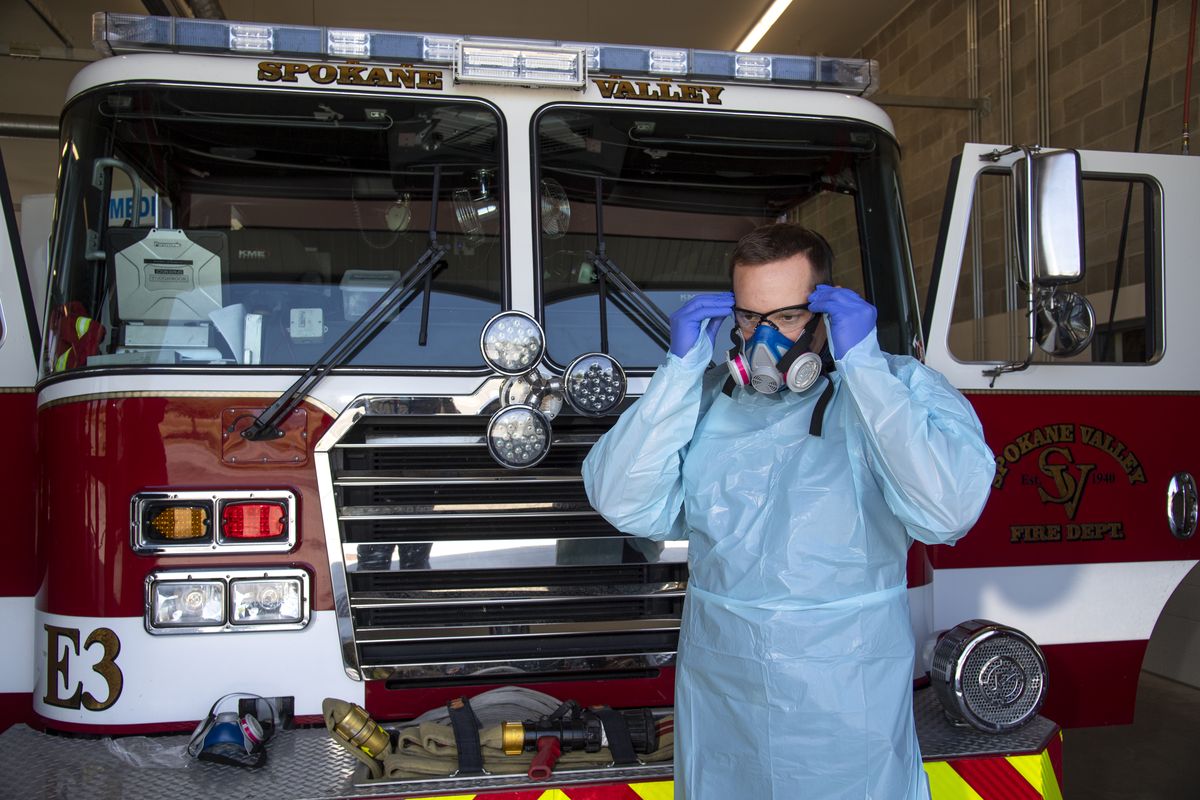Not home, but still healthy: Precautious Spokane-area first responders stem spread of COVID-19

In the midst of an evolving pandemic, very little is absolutely certain.
So it can’t be said with unwavering surety that the cautious and calculated approach taken by emergency responders in Spokane County is to credit for their relative good health – but it certainly didn’t hurt.
As community spread of COVID-19 continues to rise in Spokane County, the number of first responders out of work remains low, despite the close quarters in which they often work and high-risk situations they enter.
“So far, we haven’t really realized any sort of major impact. Pretty consistently, most of the time we’ve usually got a couple of people off, two to three on quarantine,” said Deputy Spokane Fire Chief Jay Atwood.
The success of local emergency agencies in abating the spread of COVID-19 is attributed in part to the aggressive precautionary measures they took early in the pandemic.
Fire departments in the cities of Spokane and Spokane Valley – which also reports low quarantine numbers and positive COVID-19 tests – adopted all-mask, all-the-time policies. Firefighters wear a mask whenever they’re at work, be it responding to a call or in the station.
“That won’t loosen up any time soon,” Atwood said.
In March, the Spokane Valley Fire Department announced it would no longer accept visitors at its fire stations and would be responding to potential COVID-related calls in a full protective gown.
“We were really diligent about putting in place really extreme practices,” said Julie Happy, a spokesperson for the Spokane Valley Fire Department. “We’ve been really diligent about maintaining those practices, especially while watching the cases rise.”
No one is ready to declare victory, but the measures appear to be working.
“I would like to believe our conservative approach in general, a cautious and responsible approach, and full participation by the members, has been what has kept us safe thus far,” said Dr. Joel Edminster, who serves as the medical director for the Spokane Valley, Spokane and Spokane County District 9 fire departments.
In the weeks and months since first responders began donning masks, government leaders have embraced their benefit in slowing the spread of COVID-19 and heeded the advice of public health officials by mandating their use when social distancing is impossible.
The fire departments implemented the mask policy prior to mask use becoming a political flashpoint. When it became clear that asymptomatic people could carry and spread the disease, the departments took action.
“We knew that we could take a really bad hit early on, particularly if it became discovered that somebody was symptomatic after maybe consecutive shifts in a large station,” Edminster said. “We needed to be very conservative in terms of our management and probably overly cautious – in excess of the CDC recommendations at the time.”
The departments couldn’t afford to lose their members to the disease, especially if an increasing number of people in Spokane County needed treatment for it. Though cases did not spike in April or May, the number of Spokane County residents with COVID-19 rose sharply in June and July.
“We had to make sure we were ready and able to take care of the community if it hit the fan,” Edminster said.
Spokane Valley has had four employees test positive for the coronavirus, while the city of Spokane has had just one.
The Spokane Fire Department set aside an entire station for quarantine purposes, but it hasn’t been called upon after an initial spike in the number of firefighters in quarantine.
“We still have that built into our plan if needed, but it really has not been utilized,” Atwood said.
American Medical Response, a Colorado-based company that provides ambulance services for Spokane and Spokane Valley, said in a statement to The Spokesman-Review that it has followed Centers for Disease Control and Prevention guidelines. A spokesperson did not say how many of its Spokane employees have been forced to quarantine or tested positive for the virus.
“We’re all very humble in acknowledging success, and we’re really just trying to put forth measures that protect our members and set a good example for the public,” Edminster said.
These policies could only be adopted rapidly because of the foundation of collaboration between agencies that already existed under Dr. James Nania, medical director for Spokane County Emergency Medical Services, Edminster said. That teamwork was vital, because when ambulance personnel arrive at a scene after the fire department, for example, they need to be on the same page and have the same expectations.
Edminster also credited first responders with quickly embracing the new mask norm.
“It’s not convenient, it’s not comfortable, but they took it in stride and they did it,” Edminster said.
Science doesn’t always immediately have all of the answers, Edminster said, and members understood that.
“The disease is dynamic. Our understanding needs to be fluid and our response needs to be fluid,” Edminster said. “They’re pretty damn good at seeing something they can’t control and adapting to approach it from different angles.”
Edminster and Atwood are both worried about “COVID fatigue” in the community.
“I get it, people are tired of following the mask order and being cooped up, but that’s probably a clear indicator as to why things are spreading now,” Atwood said.